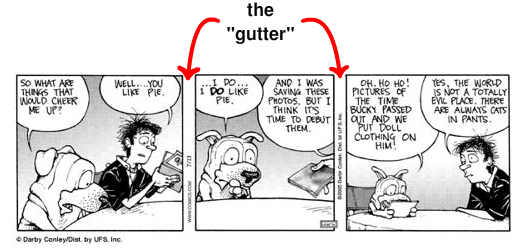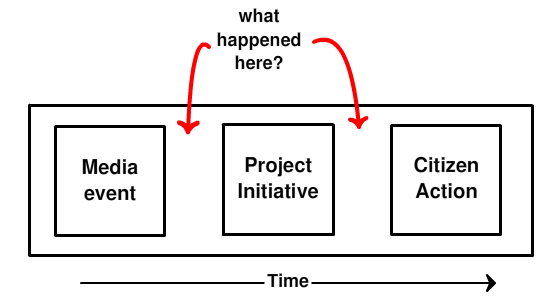 Scott McCloud understands what makes comics tick. He’s gained that insight through his work as a comic artist, and his ongoing exploration into the why comics work. I’ve read a couple of his books Understanding Comics (his best known book and which I highly recommend) and Re-inventing Comics. His storytelling has shifted to the online world. His 2005 TED presentation highlights his triangulating mind! As comics are a creative form of storytelling, I’ve tried to learn more about why they succeed, and their applicability to organizations. Scott McCloud offers up a few ideas on that front; one of which is his idea of the gutter.
Scott McCloud understands what makes comics tick. He’s gained that insight through his work as a comic artist, and his ongoing exploration into the why comics work. I’ve read a couple of his books Understanding Comics (his best known book and which I highly recommend) and Re-inventing Comics. His storytelling has shifted to the online world. His 2005 TED presentation highlights his triangulating mind! As comics are a creative form of storytelling, I’ve tried to learn more about why they succeed, and their applicability to organizations. Scott McCloud offers up a few ideas on that front; one of which is his idea of the gutter.
What is the gutter and how does it work?
Here’s an image of a comic strip. The space between each frame is what McCloud calls the gutter.
Comics are sort of a call and response. The comic artist gives you something to see in the panels, and something to imagine in-between the panels (the gutter). The gutter is where you, the reader, are invited to participate.
Comics are a form of storytelling. It’s you who observe the parts (each panel); yet still perceive the whole. When you fill in the gutter, you are applying your imagination. Together the individual panels and your imagination help bring closure, define a story in your mind.
Why is the gutter important for your organization?
Let�s think of how the comic strip framework might apply to an organization. Assume a series of discrete, although connected, set of activities to your organization; e.g., a media event, a follow-on project initiative, and some citizen action as a result of the initiative…
Many organizations are good at the creating and sharing particulars about the component parts; i.e., media materials, project summary, citizen doing x,y,z. What about other actions, thinking, and conversations taking place, inside and outside of the organization? They too are important.
It’s from an accumulation of our life experience that we connect the dots e.g., the discrete events into some sort of whole!
And, not only do we use our accumulated experiences for finding broader meaning, and crafting stories, about discrete events, it also represents our knowledge about something; a kind of residue of our actions, thinking, and conversations.
I think incorporating what takes place in the gutter, the in-between, is central to building organizational identity and capacity, and just plain good collaborative practice! (see previous posts on knowledge and storytelling – both of which are about those in-between spaces)
What happens when the gutter isn’t shared in our organization? In lieu of complexity theory and systems thinking, how authentic is the story being told?
The challenge
Incorporate more from the gutter (or at least enough of the gutter) to better authenticate your organization’s story.
What say you? What ideas do you have for bringing in the gutter?
If you enjoyed this post, please consider leaving a comment or subscribing to my blog. It helps me make it more relevant for you. Thanks, Ben.
Photo credits: alan.stoddard , TedsBlog



[…] How the Gutter Helps Authenticate the Organization of A Story […]